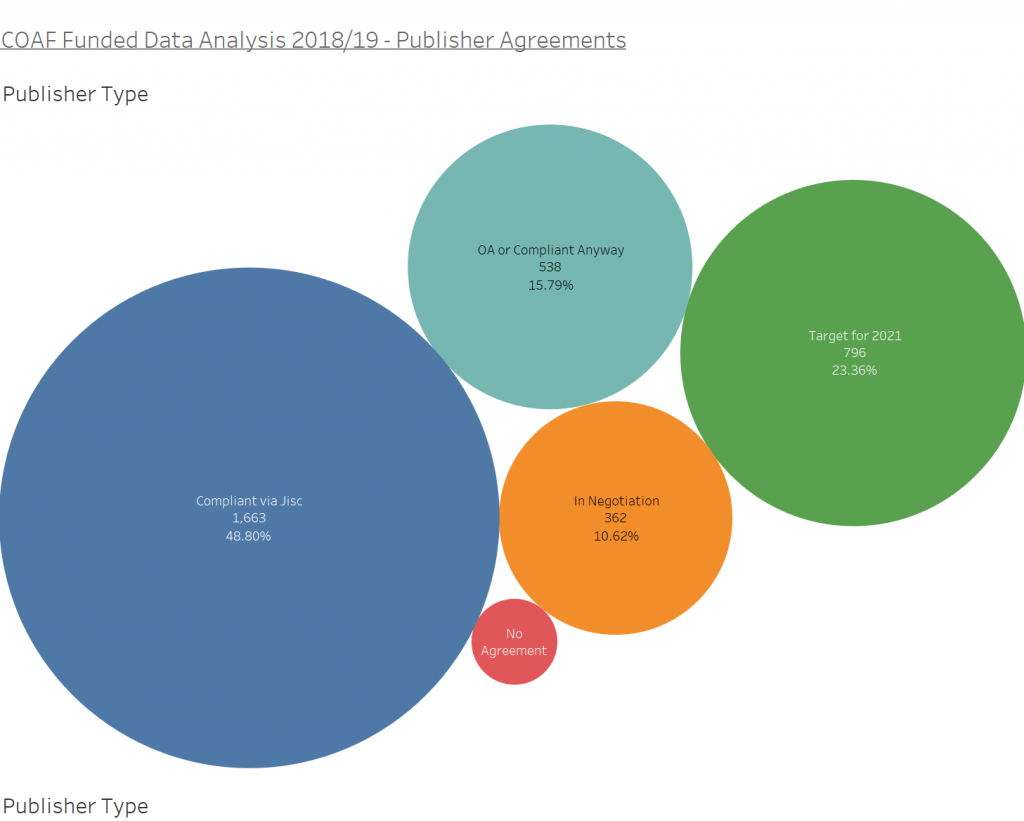January 2021 marked the launch of the new Wellcome Open Access (OA) policy and the start of the second year of the UK Wiley Read & Publish agreement. We’ve recently added resources to our webpages to help institutions support Wellcome-funded authors and get the best out of Read and publish agreements.
Wellcome compliant publishing options
We’ve been working with publishers since 2018 to negotiate agreements that fulfil the requirements of the Wellcome OA policy. Towards the end of 2020 we reviewed progress based on the list of publishers from the 2018-19 Wellcome and COAF OA Spend Report. Our analysis showed that compliant OA options are now in place with publishers of almost 70% COAF-funded research.
Jisc transitional agreements (TAs) cover over 48% and, of the 20% of research published with fully OA publishers, Jisc has negotiated ‘Pure Publish’ agreements which can reduce costs with the top 3 (PLOS, Frontiers and MDPI). Of the remaining 30%, negotiations are ongoing or will begin in 2021. Publishers of only 0.2% of COAF-funded research that Jisc has approached did not confirm an OA option to fulfil Wellcome requirements in 2020.
We’ve created a spreadsheet to provide a summary overview of TAs and negotiations with publishers of Wellcome-funded research, and you can find that on our OA webpages. All our TAs are recorded in the ESAC registry so that they feed through to cOAlition S’s Journal Checker Tool.
Read and publish agreements: community guidance and Wiley
At the start of 2021 we had 28 transformative agreements available to order (see lists of all OA agreements on our OA webpages). When we’re developing agreements, as well as working through our strategic groups, Jisc works with organisations like OA2020 and the ESAC initiative to share and incorporate best practice. We are particularly grateful to the Content Expert Group and the RLUK Open Access Publisher Processes Group which provide expert advice and guidance on a range of different agreements. These groups have provided Jisc and publishers with invaluable feedback on the implementation of OA agreements, OA workflows, and the presentation and content of author-facing communications.
Preparing for future agreements
As we continue to develop Read and publish (R&P) agreements, it’s fair to assume that publishers will seek to base future charges on the publishing services provided through these agreements. To ensure that institutions can shape the direction of future agreements it’s important that they have a shared understanding of the value of publishing services to their institution; how the agreement performs compared with other arrangements; and who can publish under each agreement, depending on their relationship to the institution. This might include understanding if the article is of a type that can be submitted in research assessment exercises (e.g., the Research Excellence Framework (REF)), or if any costs of agreements can be claimed back from funders.
Maximising the value from these agreements and minimising exposure to downstream costs will be increasingly important in the longer term, because if institutions find the cost of R&P agreements too high to sustain or they fail to cover key research outputs, there’s a risk they could disadvantage authors, including early career researchers, and impede the transition to OA.
Greater cost transparency and oversight of the performance of agreements will enable institutions to see more easily which journals or agreements are delivering the best value (value in this context might not necessarily equate to cost) and inform use of strategies, such as rights retention, and perhaps reduction of financial support to those agreements that do not.
Getting the best out of agreements
The success of agreements of this sort depends on modelling, based on historic publishing trends as well as on the use of the agreement itself, to predict use of an agreement for each calendar year, as well as for the full term of the agreement. This makes it easier for Jisc to help institutions plan author communications and budgets effectively, minimise unexpected surges in demand and achieve value for money throughout the agreement. From January 2021 institutions participating in the UK Wiley agreement will receive monthly updates on the status of the consortium fund and projections of future use, and at least 2 months’ notice will be given if any restrictions on the OA fund need to be put into place, and these measures will be standard in other agreements with publishing caps.
Together with the RLUK OAPP group, Jisc has developed 3 key principles to guide institutions in managing capped OA agreements, to help the sector get the best out of current TAs and support negotiations for future models and pricing. You can read the community guidance in our Working with transitional agreements webpage.
We welcome feedback on the new guidance and are keen to work with any publishers that would like to develop an OA agreement to support Wellcome-funded authors – please contact Helen Dobson.
(With thanks to Beth Harris for data analysis.)

